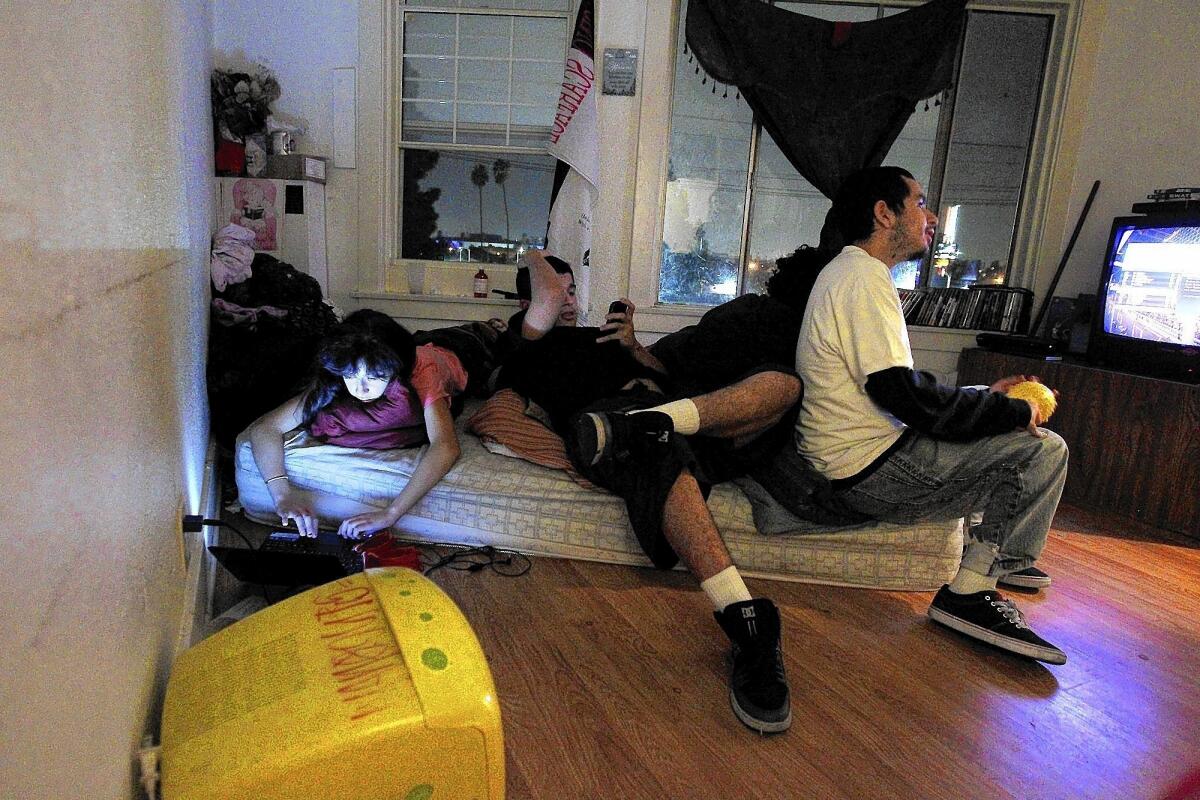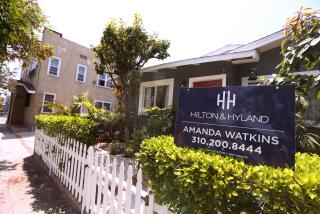L.A. and Orange counties are an epicenter of overcrowded housing

Sixteen-year-old Monica buried her face in a pillow, trying to rest for school the next day, as the clock ticked past 11 p.m.
Sleep was a battle in the tiny apartment. Hunched at the other end of the family’s only mattress, two of her brothers played a video game while a third lounged next to her, watching virtual soccer players skitter on screen. Her 2-year-old niece toddled barefoot near the door, toying with a pile of pennies.
In all, seven people live in this wedge of space in Historic South-Central, including Monica’s mother and the mother of the little girl — the longtime girlfriend of one of her brothers. They squeeze into an apartment roughly the size of a two-car garage, sharing a bathroom, a small kitchen and one common room.
“We’re not comfortable,” Monica’s mother, Josefina Cano, said in Spanish. “But what can we do? It’s better than being on the street.”
Cano and her family live in one of the most crowded neighborhoods in the country. Nearly 45% of the homes there are considered “crowded” — having more than one person per room, excluding bathrooms, according to an analysis of Census Bureau data spanning 2008 to 2012. Almost one home in six is severely crowded, with more than two people per room.
Southern California is an epicenter for crowded housing: Out of the most heavily crowded 1% of census tracts across the country, more than half are in Los Angeles and Orange counties, a Times statistical analysis found. They are sprinkled throughout areas such as Westlake and Huntington Park around Los Angeles, and Santa Ana and Anaheim in Orange County.
INTERACTIVE: Mapping the country’s crowded homes
From the outside looking in, it is a largely invisible phenomenon. Places such as Maywood and Huntington Park, south of Los Angeles, look little like the high-rises of Chicago or Boston. Yet behind the closed doors of small bungalows or squat apartment buildings, they are home to thousands more people per square mile than those large cities.
“This is an example of poverty that can go unseen in our communities,” said Jason Mandell, United Way of Greater Los Angeles spokesman. “It’s easy to miss if you’re not paying attention.”
The crowding is felt in ways big and small.
Around South Gate and Huntington Park, Head Start instructors who visit children at home find they have trouble focusing amid the hubbub. In the Florence-Firestone area, longtime resident Paula Trejo said, street parking is always scarce.
UCLA and University of North Carolina at Chapel Hill researchers have found that children in crowded homes have poorer health, worse scores on math and reading tests and more behavioral and emotional problems — such as tantrums and depression — even when poverty is taken into account.
“I don’t think anyone really wants to live in overcrowded conditions,” said Larry Gross, executive director of the Coalition for Economic Survival. “But people will endure it because they have no choice.”
::
Every inch of the apartment that Cano and her family share is consumed: Bags of clothing are heaped in the only closet. Atop the heater, under a can once used to collect funeral donations, sits a box with the ashes of Cano’s late son, who endured seizures and died in his teens.
When they yearn for more room, young mother Selene Herrera takes her toddler to the hallway to sit beside a window, the same hallway where Monica and her brothers sometimes huddle with homework.
By night, they pile onto the mattress and spread blankets on the wooden floor. Late one Sunday, Monica lost patience as the toddler played with her piggy bank.
“Quit it with the pennies,” the teen muttered in Spanish, pulling a blanket over her head to guard against the glow of the television screen.
Two years ago, Cano lost her job at a mini-market when it shut down. She said she has struggled to find work that will allow her to keep caring for one of her grown sons, who also has seizures.
Her eldest son also has been out of work, and Monica and Cano’s third son are still in high school. The family hasn’t been able to find a larger, affordable apartment that will rent to so many people, said Herrera, who interns at the community organizing group Strategic Actions for a Just Economy.
Rents have easily outpaced incomes across the region. A federal study three years ago found that between 1990 and 2009, rents in the Los Angeles metropolitan area rose more than 20% while the incomes of renters sagged 6%, after adjusting for inflation. Experts say building is unusually difficult in Los Angeles, one of the factors contributing to the affordable housing shortage.
The cramped conditions echo an earlier era, when urban reformers railed against teeming tenements. After World War II, bigger homes and better incomes afforded Americans more space, and the shrinking size of families fueled the trend by 1970. But crowding rates began creeping higher again after the immigration wave of the 1980s, census data show.
In Southern California, “that boom drew in a lot of immigrants who were very poor when they arrived,” USC demographer Dowell Myers said. “And they came into a market of very inflated prices.”
By 1990, crowding rates for renters were three times higher in Los Angeles County than the national average. At the time, Myers found that Latino immigrants lived in the most severely crowded housing. Today, Latino households in the Los Angeles area are more than a dozen times more likely to be crowded than white ones.
Some scholars argue that crowding tends to be higher among Latinos and Asians because it is more accepted in their cultures, providing a survival strategy when workers strain to cover the rent.
When Fernando and Emma Solis struggled to make the payments on their Garden Grove condominium, they turned to relatives. Six years ago, the family of four lost their home and moved in with six cousins in La Puente, bedding down in the living room. Now the four share a back cottage with a single bedroom in Bell, rearranging the living room nightly so that grown daughters Rachel and Angelica can sleep. The only bathroom is through their parents’ bedroom.
Clashing schedules sometimes keep the sisters awake. But even after 21-year-old Angelica had earned enough money between college classes to move out, she stayed to help her family. Despite their frustrations, she said, “it keeps us close.”
Mexican and Vietnamese Americans tend to have different views than whites or blacks do of what is “crowded,” according to a 2000 study, but they still suffer worsening anxiety and depression as crowding increases.
Gabriel Guerrero, for instance, complains that the noise is too much. Twelve people crowd the two-bedroom house in South Gate that he bought decades ago. After school, the clamor of the television and the chatter on phones overwhelms him.
“To go to the bathroom, you have to take a number,” the 60-year-old grandfather said with a sigh. At times, his son heads to the nearby grocery to use its restroom.
Sometimes Guerrero daydreams of selling the house and finding an apartment for just a handful of them. But then he thinks of his grown children, and their growing children, muddling along with meager paychecks or measly hours.
He sets the daydream aside. “They have nowhere to go,” Guerrero said.
Times data analyst Sandra Poindexter contributed to this report.
More to Read
Sign up for Essential California
The most important California stories and recommendations in your inbox every morning.
You may occasionally receive promotional content from the Los Angeles Times.












